
The unexpected can happen. Quickly. And one of the many results of an unanticipated event can be a financial scramble that leaves you eyeing your emergency fund.
This year, many of us have done more than just look. By mid-April, 30% of Americans—and 45% of millennials—had tapped into their emergency fund to battle the downturn caused by coronavirus, according to one survey.
Rainy days were the reason you built up your rainy-day fund in the first place, so you shouldn’t be afraid to use it. But before you do, take a beat and do a quick assessment to determine if it’s the best course of action. Here are five questions to ask yourself.
1
Is the Purchase Really Necessary?
Sometimes the choice is obvious: Food, shelter, medications and utilities are essential. A new TV with more features, while nice to have, is not. Even with a necessity like food, you may be able to cut your costs. Ask yourself, “Do I really need this premium brand? Or maybe you like to order in. While it’s good to support local restaurants during this time, do you really need that pizza delivery, or can you make one at home for less?
When making the determination, keep in mind that the longer your money remains in a savings account, the more time you’ll have for compound interest to work its magic.
2
Is This the “Unexpected” Event You Saved For?
Think about why you embarked on the journey of building up your emergency fund in the first place. You were planning for the unexpected—perhaps a layoff, a major medical issue or storm damage to your home. So be honest with yourself: Is that the type of situation you’re facing right now? Or is this a more predictable event like the holidays, your car payment or routine doctor visits?
It can be tempting to raid your fund and splurge or cover regular expenses when money is tight. But if it doesn’t meet the “unexpected” test, stay focused and save your money for a truly rainy day.
3
Is There Any Other Way You Can Pay for the Expense?
Your emergency fund may indeed be your only option. But keep your eye on the compound-interest prize and think creatively about other ways to cover short-term expenses.
If you’ve been laid off, apply for unemployment. Taking care of a sick family member? Inquire about paid family leave benefits. If you’re worried about rent or mortgage payments, contact your landlord or lender—there may be solutions you’re not aware of. Perhaps you can negotiate your utility bill down or shop around for insurance. Or maybe using a credit card makes sense as a short-term solution, if you can pay it off before racking up interest charges.
4
How Much of Your Fund Will You Be Using?
When considering a withdrawal from your emergency fund, it’s important to look at the relative size of the expense. How big a percentage of your savings is this? If you’re just taking a small piece of your stockpile to pay for it, you can afford to be more lenient with yourself. If it’s a large percentage, take a moment and ask yourself the above questions one more time.
5
How Long Will It Take to Rebuild Your Savings?
Your emergency savings may be a longtime work in progress, involving sacrifices large and small along the way. After dipping into this account, you’ll want to build it back up so it’s at the optimal level for you.
When you do, will you be starting from 50%? Less? Consider how long the rebuilding process will take and assess your commitment to it. Can you be as diligent a saver now as when you first started?
Remember that rain clouds don’t stick around forever. Quick strategizing now could help you emerge with your emergency fund intact—and growing—when the sunshine returns.
Rich Beattie is a former executive digital editor of Travel + Leisure and has written for outlets such as The New York Times, Popular Science, New York Magazine and SKI.

